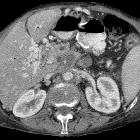Autoimmunpankreatitis






















Autoimmune pancreatitis (AIP) is a form of chronic pancreatitis associated with autoimmune manifestations on clinical, histological, and laboratory grounds .
Distinguishing this entity from other forms of chronic pancreatitis (such as alcohol-induced) is important as steroid treatment is effective both in reversing morphologic changes but also to return pancreatic function to normal .
Epidemiology
The condition is rare, with an exact incidence unknown but with an increasing number of cases reported in the literature . It is thought to account for 5-11% of chronic pancreatitis cases.
Age of presentation is variable, and there appears to be a male predilection (male to female ratio is 2:1) .
Clinical presentation
Clinical presentation is also variable, including :
- jaundice
- weight loss
- new-onset diabetes mellitus
- extrapancreatic manifestations, with lymphocytic infiltration
- inflammatory bowel disease
- pulmonary involvement
- renal involvement
- biliary tree
- salivary glands
- elevated IgG and antinuclear antibody levels >50% of cases
- abdominal pain and acute pancreatitis are unusual
Sometimes serum amylase and lipase are raised as well as a raised alkaline phosphatase.
Pathology
It is a type of chronic pancreatitis characterized by a heterogeneous autoimmune inflammatory process in which prominent lymphocytic infiltration with associated fibrosis of the pancreas causes organ dysfunction.
The cause is unknown though there is a strong basis for an autoimmune process where antibody reaction against carbonic anhydrase and lactoferrin has been postulated .
Diagnostic criteria have been established,see article diagnostic criteria for autoimmune pancreatitis for further details .
Macroscopic appearance
Diffusely indurated and firm pancreas, with some patients demonstrating a focal mass.
Microscopic appearance
Collar-like periductal infiltrates composed of lymphocytes and plasma cells , with the lymphocytes being CD8+ and CD4+ T lymphocytes.
Clusters of inflammatory cells are also seen in the walls of small veins and nerves as well as medium and large-sized vessels.
Interlobular septa are thickened by a proliferation of myofibroblasts and infiltrated by lymphocytes and plasma cells.
Other organs can also be involved with a lymphocytic infiltrate: gallbladder, biliary tree, kidney, lung and salivary glands more commonly.
Associations
- IgG4-related sclerosing disease
- rheumatoid arthritis
- Sjögren syndrome
- inflammatory bowel disease (IBD)
- IgG4-related sclerosing cholangitis (up to 39%)
- in Japanese patients: haplotypes DRB1 and DQB1
Radiographic features
CT
- diffuse or focal enlargement of the pancreas with loss of definition of the pancreatic clefts
- minimal peripancreatic fat stranding, with inflammatory thickening confined to the peripancreatic region not extending into the mesentery, anterior pararenal fascia or lateroconal fascia
- a peripancreatic rim of low attenuation "halo"
- when focal involvement, typically head and uncinate process and may be iso- or hypo-dense to pancreatic tissue
- the pancreas may appear normal
- pancreatic dilatation and/or biliary dilatation may be seen
Contrast enhancement is helpful as autoimmune pancreatitis demonstrates reduced enhancement during the pancreatic phase (~40 seconds) but near normal enhancement at portal venous phase (70 seconds) .
Other sites also seem to be involved:
- peripancreatic lymph-nodes >1 cm
- kidney: inflammatory pseudotumors: hypoattenuating lesions
- retroperitoneal fibrosis: with periaortic soft tissue
- pleural effusions
- CBD: strictures
- mediastinal nodes
MRI
MRI demonstrates diffuse pancreatic enlargement .
- T1: decreased signal intensity
- T2: minimal increased signal intensity
- T1 C+ (Gd): delayed parenchymal enhancement on dynamic imaging
- DWI/ADC:
- shows diffusion restriction with high DWI signal and low ADC signal
- the reduction in ADC values can be lower than with pancreatic cancer
- DWI signal may be useful as a marker for determining the indication for steroid therapy
MRCP: multiple intrahepatic duct strictures and common bile duct; diffuse narrowing of the main pancreatic duct
ERCP
Can be normal. Biliary duct abnormalities are common with strictures of the CBD and short intrahepatic duct strictures representing PSC.
Diffuse irregularity and narrowing of the main pancreatic duct (as distinct from pancreatic carcinoma).
Treatment and prognosis
Treatment with steroids usually leads to the resolution both of morphological changes and a return to normal pancreatic function, with remission seen in 98% of cases . The condition is however also frequently self-limiting, with a spontaneous remission rate of up to 74% .
Relapse rates are high, seen in 24% of patients treated with steroids. The rate is higher in untreated patients .
Autoimmune pancreatitis accounts for 2-6% of patients who undergo pancreatic resection because they are suspected of having pancreatic cancer .
History and etymology
It was first described in 1995 by Yoshida et al. .
Differential diagnosis
For the diffuse form consider:
- lymphoma: pancreatic lymphoma
- plasmacytoma
- pancreatic metastases
- diffuse infiltrative pancreatic ductal adenocarcinoma
In these conditions, the pancreas is heterogeneously enhancing and an irregular pancreatic contour is seen.
For the focal form consider:
- pancreatic ductal adenocarcinoma
- adenocarcinomas tend to have minimal enhancement both on pancreatic (late arterial, ~40 seconds) and hepatic phase imaging, whereas autoimmune pancreatitis demonstrates near-normal enhancement during hepatic phase (portal venous, ~70 seconds)

 Assoziationen und Differentialdiagnosen zu Autoimmunpankreatitis:
Assoziationen und Differentialdiagnosen zu Autoimmunpankreatitis:





